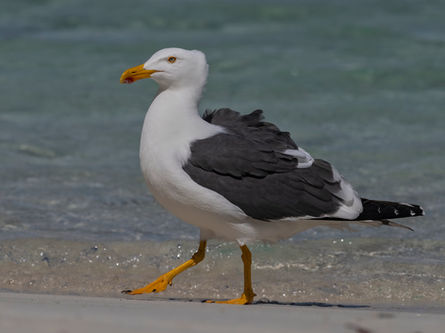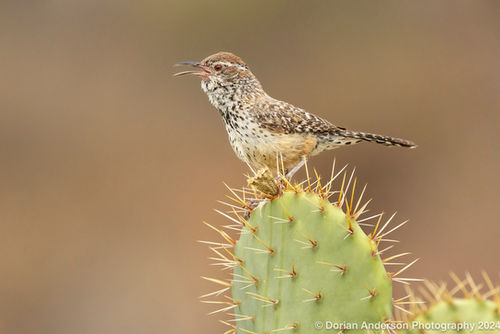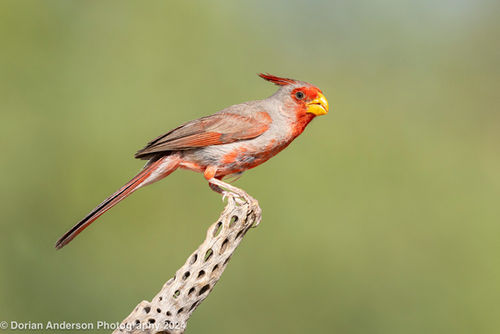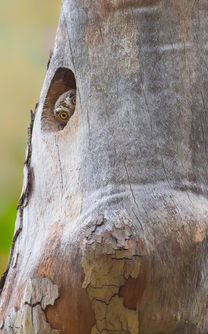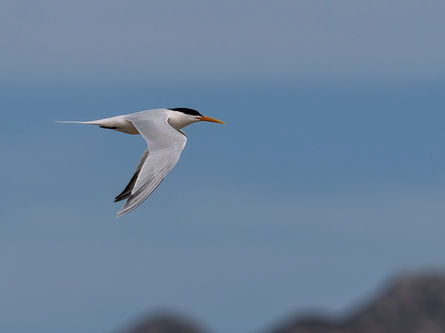Mexico: Birding Beautiful Baja California
Tour Overview:
This is a relaxed winter tour sprinkled with endemic and specialty birds, beautiful desertscapes, and also includes whale-watching boat trips, plus an option to snorkel with Whale Sharks too. It is one of the ultimate winter getaways, with sun, sea, sand, birds, and marine animals. Among the targets will be Belding’s Yellowthroat, Xantus’s Hummingbird, Elf Owl, Baird’s Junco, California Towhee, as well as Whale Sharks and Gray Whales.
Detailed Itinerary
Day 1: Arrival in San Jose del Cabo
After arrival in this resort city at the southern tip of Baja California’s Peninsula, you will be transferred to a nice beach resort for the night. Early arrivals can explore the beaches and colonial buildings of the area if desired. There is no birding on this day, so you are free to arrive when you wish, although the tour starts with a dinner meeting and briefing this night, so please try and arrive at the hotel by 6pm. A single night will be spent in a beachside resort.
Day 2: Estero San Jose del Cabo
This part of Baja California is dominated by arid habitats, and so this large wetland, the only coastal lagoon in Baja California Sur, acts like an oasis for waterbirds, provided by this island of rich bird habitat. We will search among the reeds and cattails for one of the major avian targets of the tour, the Belding’s Yellowthroat, a restricted range, endangered, species that is endemic to Baja California. At this time of year, the lagoon is loaded with wetland birds, including migrants from the north that supplement the year-round residents, like Least, Western, and Clark’s Grebes, Redhead, Ring-necked Duck, Cinnamon Teal, Heerman’s and Yellow-footed Gulls, Elegant Tern, Brandt’s Cormorant, Least Bittern, Reddish Egret, and a mass of wintering sandpipers, plovers, and stilts.
As mentioned previously, the surrounding area is desert, and we will occupy ourselves with the rich avifauna in the surrounding area this later in the day, with birds like Gila Woodpecker, Gilded Flicker, Vermilion Flycatcher, California Scrub-Jay, Verdin, Phainopepla, and Hooded and Scott’s Orioles all possible amongst the cacti. We will be keeping a special eye out for more local species, particularly Xantus’s Hummingbird, Gray Thrasher, and Chestnut-rumped Seedeater. At dusk, we will seek Elf Owl, the world’s smallest owl, in these deserts too. The night will be spent in a beach town on the eastern side of Baja California Sur.
Day 3: Reserva de la Biosfera Sierra de la Laguna
Our second day chasing local avian specialties will take us up into a low mountain range that slices through Baja California Sur. Depending on access and road conditions (roads are rough and need 4x4, or a tough hike), we may be able to find the montane endemic Baird’s Junco. Even if we don't locate it, there are plenty of other great birds in the pine-oak woodland in the Sierra; there are a number of local subspecies which we will be keen to see, in case they are split into endemic species in the future. This includes Northern Pygmy-Owl, American Robin, Acorn Woodpecker, Band-tailed Pigeon, Oak Titmouse, White-breasted Nuthatch, and Spotted Towhee. Other birds of interest here include both Xantus’s and Costa’s Hummingbirds, California Towhee, and Black-throated Gray-Warbler. After a morning on the mountain, we will drive north to the state capital La Paz. The first of two nights will be spent into the north, in the state’s beachside La Paz.
Day 4: Whale Shark Boat Trip & La Paz birding hotpots
This morning our focus will change from birds to marine wildlife and in particular Whale Sharks, when there will be an optional snorkeling session to see them up close too. In the afternoon, we will return to dry land and have some casual birding close to La Paz. There are excellent wetlands in the area loaded with ducks, gulls, terns, shorebirds (including Long-billed Curlew), and Yellow-headed Blackbirds, while frigatebirds patrol the skies overhead. In the surrounding arid habitats we can find species like Cassin’s Kingbird, Cactus Wren, Violet-green Swallow, California Gnatcatcher, and MacGillivray’s Warbler. A second night will be spent in a good hotel in La Paz.
Day 5: La Paz to San Carlos; afternoon Gray Whale Boat Trip
During the morning we will drive across the peninsula, heading to the northeast of it, and the coastal town of San Carlos. In the afternoon, we will take our first boat trip out of there to see Gray Whales up close at the very best time to see them. A single night will be spent in the coastal port of San Carlos.
Day 6: Gray Whale Boat Trip 2 and Todos Santos
A second boat trip is scheduled in the morning to study the Gray Whales again. By planning two boat trips we have the very best chance at seeing the whales well, even if there are unforeseen cancelations of one of them. In the afternoon we will make the long drive south to the town of Todos Santos on the southwest side of the peninsula, where we will spend our final night. There may be some time in the late afternoon for some birding close to Todos Santos, where we could find Gilded Flicker, Verdin, or Hooded or Scott’s Orioles, as well as plentiful waterbirds in the coastal areas.
Day 7: Departure from San Jose del Cabo
After some brief, final, birding in the morning, we will travel back to the city of San Jose del Cabo for afternoon departures out.
Trip Considerations
PACE: Moderate, but the Whale Shark day is more intense (see below). Fairly early starts (6:00am-6:30am) are generally required, as this is the coolest time of day in this arid climate for birding, with the best activity early in the morning. On one day, for the hike up Sierra de la Laguna, we will have breakfast earlier, at around 5:30am. On most days, there will be time to relax in the heat of the day at the hotel. There will be some optional nightbirding on one or two days, but you will be able to have a short break before dinner on most days. One or two breakfasts may be taken in the field. Lunch and dinner are always sit-down affairs. There are two long drives on this tour, of 3.5 hours between La Paz and San Carlos, and then of around 4.5 hours between San Carlos and Todos Santos. Almost all of the roads are paved on this tour. The Whale Shark outing is a pretty intense full day outing, which involves (optional) snorkeling in a wet suit in cold water, and we will travel in a small speed boat that tends to bang against the waves when at full speed.
PHYSICAL DIFFICULTY: Easy to Moderate. The birding is done mostly on roads and easy trails, and so this is not a difficult tour physically. There is one steeper trail on day 3 to Sierra de la Laguna, which involves a gain in altitude of around 1300ft/400m, and a distance of around 2 miles/3.5km each way. This tour spends almost all of the time at low altitudes, near sea level, except on day 3, when an elevation of around 6560ft/2000m is reached on Sierra de la Laguna. There are 3 boat rides on the tour, and so you may need to take motion sickness pills if you are affected by this.
CLIMATE: At this time of year the climate is warm and dry in Baja, with little chance of rain, and much more pleasant temperatures than in the summer. For most of the tour (i.e. all days except day 3 when on the Sierra), the temperatures will be between 15C (59F) and 27C (80F). It will be a few degrees cooler, and windier up on the Sierra for that single day.
ACCOMMODATION: Very good throughout, with en-suite facilities, 24-hour hot water, 24-hour electricity and WIFI is available in all accommodations used. This is a very comfortable tour.
PHOTOGRAPHY: This is a natural history tour, where we are likely to have good chances to photograph some of the birds on the fly (there are no feeders), as well as Gray Whales (and Whale Sharks if you have an underwater camera).
Other Information
TRAVEL REQUIREMENTS: A valid passport is required; it must be valid for at least six months past your intended stay. Citizens of the US, Canada, EU, Australia, New Zealand, and Japan, do not currently require a tourist visa. For other nationalities, please check with the nearest embassy or consulate, or ask our office staff if you are unsure. Travel requirements are subject to change; it is a good idea to double check six weeks before the trip.
WHAT’S INCLUDED?: Tips to drivers, local guides, and lodge staff; accommodation from the night of day 1 to the night day 6; meals from dinner on day 1 (unless you arrive too late for dinner service) to breakfast on day 7; safe drinking water throughout; Tropical Birding tour leader with scope and audio gear from the evening of day 1 to the night of day 6; one arrival and one departure airport transfer per person (transfers may be shared with other participants of the same tour if they are on the same flight); ground transport for the group to all sites in the itinerary in a suitable rental vehicle with the Tropical Birding guide as the driver also; 1 boat trip out of La Paz for Whale Sharks with optional snorkeling; 2 boat trips out of San Carlos for Gray Whales; entrance fees to birding sites mentioned in the itinerary; a printed and bound checklist to keep track of your sightings (given to you at the start of the tour – only electronic copies can be provided in advance).
WHAT’S NOT INCLUDED?: Optional tips to the Tropical Birding tour leader; tips for luggage porters in any hotels/lodges (if you require their services); international flights; excess luggage charges; snacks; additional drinks apart from those included; alcoholic beverages; travel insurance; excursions not included in the tour itinerary; extras in hotels such as laundry service, minibar, room service, telephone calls, and personal items; medical fees; other items or services not specifically mentioned as being included.
Tour Reviews
*Participated on this Tour? Leave a Review! We would also love to see your favorite photo, upload it!







